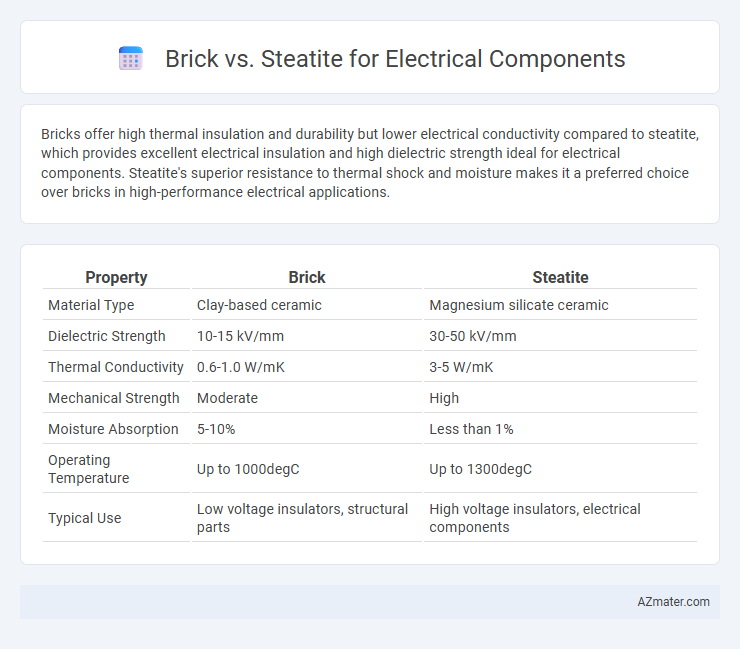Bricks offer high thermal insulation and durability but lower electrical conductivity compared to steatite, which provides excellent electrical insulation and high dielectric strength ideal for electrical components. Steatite's superior resistance to thermal shock and moisture makes it a preferred choice over bricks in high-performance electrical applications.
Table of Comparison
| Property | Brick | Steatite |
|---|---|---|
| Material Type | Clay-based ceramic | Magnesium silicate ceramic |
| Dielectric Strength | 10-15 kV/mm | 30-50 kV/mm |
| Thermal Conductivity | 0.6-1.0 W/mK | 3-5 W/mK |
| Mechanical Strength | Moderate | High |
| Moisture Absorption | 5-10% | Less than 1% |
| Operating Temperature | Up to 1000degC | Up to 1300degC |
| Typical Use | Low voltage insulators, structural parts | High voltage insulators, electrical components |
Introduction: Comparing Brick and Steatite in Electrical Applications
Brick and steatite serve distinct roles in electrical components due to their differing material properties. Brick, primarily composed of clay, offers good mechanical strength but limited electrical insulation and thermal resistance. Steatite, a dense ceramic made from talc and other minerals, provides superior electrical insulation, high dielectric strength, and excellent thermal stability, making it ideal for high-voltage and high-temperature applications.
Material Composition and Properties
Brick electrical components typically consist of ceramic materials rich in alumina and silica, offering excellent thermal insulation and mechanical strength. Steatite, composed primarily of magnesium silicate, provides superior dielectric properties, high resistance to thermal shock, and stable performance at elevated temperatures. The choice between brick and steatite hinges on the required thermal conductivity, dielectric strength, and mechanical durability for specific electrical applications.
Electrical Insulation Capabilities
Steatite exhibits superior electrical insulation properties compared to traditional brick materials, offering high dielectric strength and excellent resistance to electrical breakdown. Its low electrical conductivity and thermal stability make steatite ideal for insulating components in high-voltage applications, ensuring minimal leakage currents and enhanced safety. In contrast, bricks generally have higher porosity and lower dielectric strength, limiting their effectiveness as electrical insulators in demanding environments.
Thermal Conductivity and Heat Resistance
Steatite offers superior thermal conductivity and heat resistance compared to brick, making it ideal for electrical components requiring efficient heat dissipation and high-temperature durability. Its thermal conductivity typically ranges between 7 to 20 W/m*K, significantly higher than common bricks, which average around 0.7 to 1.5 W/m*K. Steatite also withstands temperatures above 1100degC without deformation, while bricks may degrade or crack under prolonged thermal stress, highlighting steatite's reliability in demanding electrical insulation and heat management applications.
Mechanical Strength and Durability
Steatite offers superior mechanical strength compared to traditional brick, making it ideal for high-stress electrical components requiring enhanced durability. Its high compressive strength and resistance to thermal shock result in longer-lasting performance under varying electrical loads. Brick, while cost-effective, generally exhibits lower mechanical robustness and is more prone to cracking under mechanical or thermal stress, limiting its use in demanding electrical applications.
Manufacturing Process and Cost Factors
Steatite requires precise powder processing and high-temperature sintering to achieve its ceramic properties, leading to longer manufacturing cycles and higher equipment costs compared to brick production, which involves simpler clay molding and kiln firing. The raw materials for bricks are generally abundant and inexpensive, reducing overall costs, while steatite's specialized minerals and complex processing drive up expenses. Cost factors are influenced by the durability and electrical insulation properties of steatite, justifying its higher price in applications demanding superior performance.
Applications in Electrical Components
Bricks, commonly made from clay or ceramic materials, are frequently used as insulating bases and structural supports in electrical components due to their high dielectric strength and thermal resistance. Steatite, a type of dense ceramic composed mainly of talc, offers superior electrical insulation, excellent mechanical strength, and resistance to thermal shock, making it ideal for high-performance insulators, electrical bushings, and substrates in electronic circuits. Applications in electrical components favor steatite when precise insulation and durability are critical, while bricks serve well in less demanding environments requiring cost-effective insulation solutions.
Longevity and Maintenance Requirements
Steatite offers superior longevity compared to traditional brick due to its dense ceramic composition, which resists moisture, heat, and electrical stress more effectively. Maintenance requirements for steatite are minimal as it withstands wear and environmental factors without significant degradation, whereas brick components may require frequent inspection and repair due to potential cracking and porosity. Selecting steatite ensures enhanced durability and lower long-term maintenance costs in electrical applications.
Environmental Impact and Sustainability
Steatite offers superior environmental benefits over traditional bricks due to its natural mineral composition and lower energy consumption during manufacturing. Unlike clay bricks, steatite components resist chemical corrosion and thermal degradation, extending the lifespan of electrical parts and reducing waste. The recyclability and minimal resource extraction of steatite contribute to a more sustainable lifecycle for electrical components in eco-conscious applications.
Conclusion: Selecting the Right Material for Electrical Components
Brick offers cost-effective insulation with decent mechanical strength, making it suitable for general electrical component housing where budget constraints are critical. Steatite, composed mainly of magnesium silicate, provides superior electrical insulation, high thermal resistance, and exceptional durability, ideal for high-performance or high-temperature applications. Choosing between brick and steatite depends on the specific electrical, mechanical, and thermal requirements of the component to ensure optimal performance and longevity.

Infographic: Brick vs Steatite for Electrical Component
 azmater.com
azmater.com